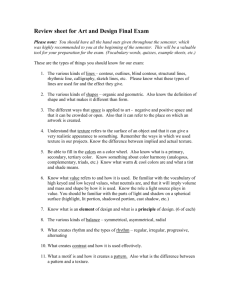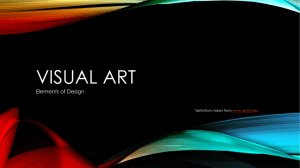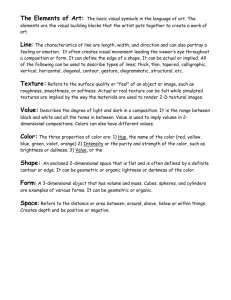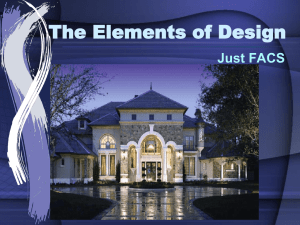Complementary - Cloudfront.net
advertisement
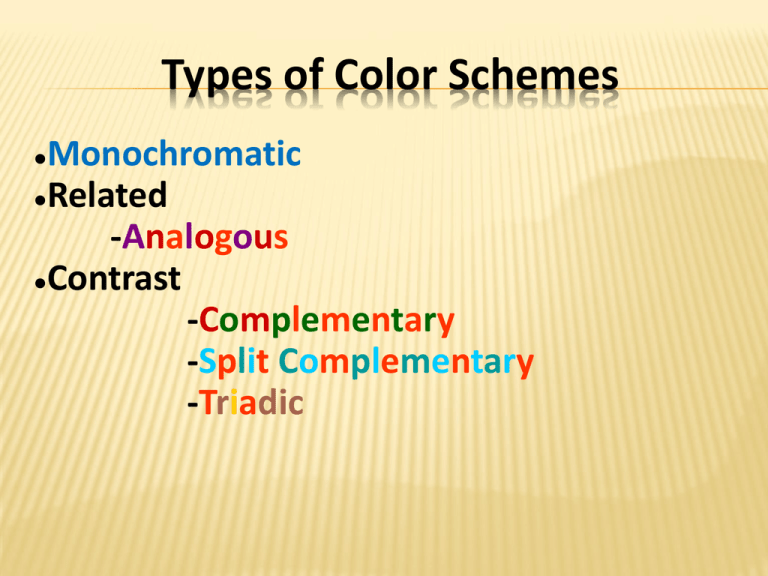
Types of Color Schemes Monochromatic ●Related -Analogous ●Contrast -Complementary -Split Complementary -Triadic ● Monochromatic ● One color and its values Analogous Colors ● ● 2 of 3 similar adjacent colors on a color wheel Often also used with a neutral color Contrast Complementary Colors that are direct opposite each other on the color wheel ●Complementary colors are “opposites” and generally result in good contrast ●Naturally go well together ● Split Complementary A color and the two colors that are next to the complementary color ● Triad Color Scheme ● ● Any three colors spaced equally from each other in the color wheel Creates an equilateral triangle on the color wheel RED ● ● ● ● ● ● ● Anger Excitement Love Dominant Strong Intense Active BLUE ● ● ● ● ● ● Calm Sad Comfort Security Loyalty Trust YELLOW ● ● ● Happy Cheerful Energetic GREEN ● ● ● ● ● ● ● Calm Happy Natural Quietness Refreshment Endurance Stability ORANGE ● ● ● ● ● Exciting Upsetting Distressing Determination Success PURPLE ● ● ● ● ● ● Defined Royal Distinguished Power Ambition Luxury WHITE *yes technically it’s a “value” not a true color ● ● ● ● ● ● ● Purity Goodness Light Innocence Positive Simple Clean BLACK *yes technically it’s a “value” not a true color ● ● ● ● Elegant Powerful Formal Death Elements of Design SPACE • Space is the 3 dimensional expanse that a designer is working with. – Large, open spaces give people a feeling of freedom and luxury. • • • – Too much open space can make people feel lonely and uncomfortable. Rooms with high ceilings or too few furnishings can have this effect as well. Empty parts of room may look larger than smaller areas containing furniture. Crowded spaces with too much furniture may make you feel confined. • On the other hand, you may feel snug and secure. LINE • • • Line outlines form and conveys a sense of movement or direction. Lines can be used to convey a sense of strength, serenity, gracefulness, or action. All lines are either straight or curved and are placed in a direction, vertical, horizontal, or diagonal. – Vertical lines can convey strength and stability • – – – (pinstriped suit) A horizontal line may suggest rest. Diagonal or zigzag lines evoke excitement and movement. Curved lines have a graceful and delicate effect. FORM • Form describes the shape and structure of solid objects. Large heavy objects such as pianos or sofas give a feeling of stability. – – • Their massive appearance adds a solid feeling to the room. Placing several small objects together will create stability as well (such as 2 chairs and a table grouped together) Designers are usually more concerned with apparent weight rather than actual weight. – – Light colors pair with other light colors equal a lightness Light colors paired with dark colors may add weight. TEXTURE • • Texture An object’s texture is the appearance or feel of its surface. Texture can influence the way people feel in a room. – – – – • Plush carpet and furniture covered with soft fabric provide a sense of comfort. Nubby, rough materials convey a feeling of ruggedness and stability. Smooth velvets and heavy brocades suggest luxury. Glass, metal and stone give a feeling a coolness. Texture can also affect apparent size. – – Soft silky fabric on a couch may seem smaller than rough and ragged fabric on a couch. Smooth textures reflect light and rough textures absorb light. Principles of Design BALANCE SYMMETRICAL BALANCE Creates a quiet, restful feeling. Suggests restraint, orderliness, formality. Also called, FORMAL balance. ASYMMETRICAL BALANCE Creates more interesting arrangements. Suggests informality, relaxed. Also referred to as INFORMAL balance. RHYTHM Rhythm by Repetition Rhythm by Gradation Rhythm by Radiation Rhythm by Opposition Rhythm by Transition SCALE AND PROPORTION SCALE Relates to the actual and relative size and visual weight of the design and its components. Furniture and accessories must be in scale to the room PROPORTION The Golden Mean – the division of a line or form so that the smaller portion has the same ratio to the larger as the larger has to the whole. The creative use of color, texture, pattern, and furniture arrangement can create illusions of properly proportioned space. EMPHASIS The center or focus of attention and interest within a design HARMONY UNITY Unity occurs when all the parts of a home or room are related by one idea. A unified design has consistency of style VARIETY When two or more different elements of design are used to add interest to a design. Variety can be achieved by combining different styles and materials, as long as they are compatible.


